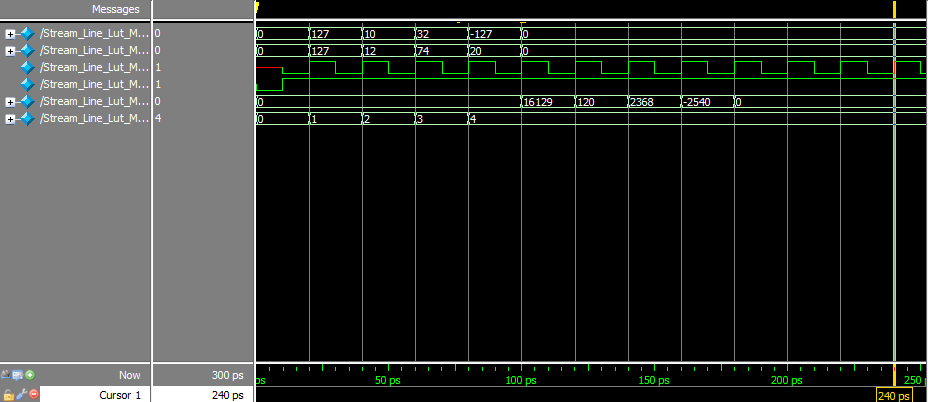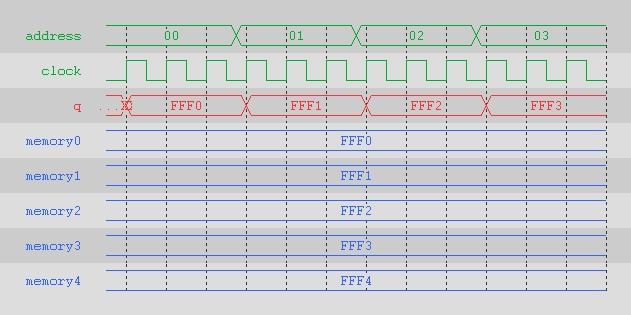流水线利用非阻塞赋值赋予的是上一时钟周期寄存器的值,来实现对寄存器的依次更新值。如:
always @ ( posedge CLK )
begin
//A[m]表示,一维数组A 中第m 个元素。
//A[m][n]表示,一维数组A 中第m 个元素,第n 位。
A[0] <= A_input; // 从外部读取新的A 值
A[1] <= A[0] | 4'b0001; // 读取A[0]值,并且设置第0 位,然后赋予A[1]
A[2] <= A[1] | 4'b0010; // 读取A[1]值,并且设置第1 位,然后赋予A[2]
A[3] <= A[2] | 4'b0100; // 读取A[2]值,并且设置第2 位,然后赋予A[3]
A[4] <= A[3] | 4'b1000; // 读取A[3]值,并且设置第3 位,然后赋予A[4]
end
虽然在一个时钟周期内,但完成A[4]的赋值仍需要5个时钟周期,这正是非阻塞赋值的特性,每次只能更新一次上一个时钟沿寄存器的值。虽然第一次需要5个时钟周期完成,但下一个数据的处理按照时钟的概念,依次进入某一拍子中进行处理,以后的数据处理将不需再等待所谓数据的“潜伏期”。如下图所示:当经过4个潜伏期之后,便会连续的输出结果。

顶层.v文件,例化方式采用位置例化方法,注意端口次序的先后对应:

1 module Stream_Line_Lut_Multiplier 2 ( 3 input CLK, 4 input RSTn, 5 6 input [7:0]A, 7 input [7:0]B, 8 9 output [15:0]Product 10 11 ); 12 13 /********************/ 14 15 wire [8:0]U1_I1_Out; 16 wire [8:0]U1_I2_Out; 17 18 task1_module U1( CLK, RSTn, A, B, U1_I1_Out, U1_I2_Out ); 19 20 wire [7:0]U2_I1_Out; 21 wire [7:0]U2_I2_Out; 22 23 task2_module U2( CLK, RSTn, U1_I1_Out, U1_I2_Out, U2_I1_Out, U2_I2_Out ); 24 25 wire [15:0]Q1_Sig; 26 wire [15:0]Q2_Sig; 27 28 lut_module U3a( CLK, U2_I1_Out, Q1_Sig ); 29 lut_module U3b( CLK, U2_I2_Out, Q2_Sig ); 30 31 /*************************/ 32 33 assign Product = Q1_Sig + ( ~Q2_Sig + 1'b1 ); 34 35 /*************************/ 36 37 endmodule 38 39 module task1_module 40 ( 41 42 input CLK, 43 input RSTn, 44 45 input [7:0]A, 46 input [7:0]B, 47 48 output [8:0]I1_Out, 49 output [8:0]I2_Out 50 51 ); 52 53 /***************************/ 54 55 reg [8:0]I1; 56 reg [8:0]I2; 57 58 always @ ( posedge CLK or negedge RSTn ) 59 if( !RSTn ) 60 begin 61 62 I1 <= 9'd0; 63 I2 <= 9'd0; 64 65 end 66 else 67 begin 68 69 I1 <= { A[7], A } + { B[7], B }; 70 I2 <= { A[7], A } + { ~B[7], ( ~B + 1'b1 ) }; 71 72 end 73 74 /***************************/ 75 76 assign I1_Out = I1; 77 assign I2_Out = I2; 78 79 /***************************/ 80 81 endmodule 82 83 84 85 module task2_module 86 ( 87 input CLK, 88 input RSTn, 89 90 input [8:0]I1_In, 91 input [8:0]I2_In, 92 93 output [7:0]I1_Out, 94 output [7:0]I2_Out 95 ); 96 97 /************************/ 98 99 reg [8:0]I1; 100 reg [8:0]I2; 101 102 always @ ( posedge CLK or negedge RSTn ) 103 if( !RSTn ) 104 begin 105 106 I1 <= 9'd0; 107 I2 <= 9'd0; 108 109 end 110 else 111 begin 112 113 I1 <= I1_In[8] ? ( ~I1_In + 1'b1 ) : I1_In; 114 I2 <= I2_In[8] ? ( ~I2_In + 1'b1 ) : I2_In; 115 116 end 117 118 /************************/ 119 120 assign I1_Out = I1[7:0]; 121 assign I2_Out = I2[7:0]; 122 123 /************************/ 124 125 endmodule
LUT_Rom存放的数据:

1 0 0 1 2 4 6 9 12 2 16 20 25 30 36 42 49 56 3 64 72 81 90 100 110 121 132 4 144 156 169 182 196 210 225 240 5 256 272 289 306 324 342 361 380 6 400 420 441 462 484 506 529 552 7 576 600 625 650 676 702 729 756 8 784 812 841 870 900 930 961 992 9 1024 1056 1089 1122 1156 1190 1225 1260 1296 1332 1369 1406 1444 1482 1521 1560 1600 1640 1681 1722 1764 1806 1849 1892 1936 1980 2025 2070 2116 2162 2209 2256 2304 2352 2401 2450 2500 2550 2601 2652 2704 2756 2809 2862 2916 2970 3025 3080 3136 3192 3249 3306 3364 3422 3481 3540 3600 3660 3721 3782 3844 3906 3969 4032 4096 4160 4225 4290 4356 4422 4489 4556 4624 4692 4761 4830 4900 4970 5041 5112 5184 5256 5329 5402 5476 5550 5625 5700 5776 5852 5929 6006 6084 6162 6241 6320 6400 6480 6561 6642 6724 6806 6889 6972 7056 7140 7225 7310 7396 7482 7569 7656 7744 7832 7921 8010 8100 8190 8281 8372 8464 8556 8649 8742 8836 8930 9025 9120 9216 9312 9409 9506 9604 9702 9801 9900 10000 10100 10201 10302 10404 10506 10609 10712 10816 10920 11025 11130 11236 11342 11449 11556 11664 11772 11881 11990 12100 12210 12321 12432 12544 12656 12769 12882 12996 13110 13225 13340 13456 13572 13689 13806 13924 14042 14161 14280 14400 14520 14641 14762 14884 15006 15129 15252 15376 15500 15625 15750 15876 16002 16129 16256 10
实验过程出现的问题:
1、前些天刚做过LUT乘法实验,同样查表是用ROM生成的,但这次好几次都是输出全0.
问题所在:生成ROM的过程中,器件选型要与工程所用器件一直。
2、使用quartus中TestBench的向导Processing->start->Start TestBench Template Writer时,前提要在设置中设置好仿真工具Modelsim Altera,才能进行模版的生成。
收获:模版生成貌似挺有用的说,利用模版里边的端口映射模块,可以很简单的用在模块例化的端口映射中,这在端口量很大的工程中很能提高效率。O(∩_∩)O哈哈~
3、用Modelsim仿真发现,通过调用ROM来实现查表与直接写一个.v的ROM文件相比,前者比后者多了一个潜伏期,这是为何?
问题所在:在ROM配置的第二页最上边部分,有“What ports should be registered?”选项,意为哪些端口需要被寄存器寄存一拍,输出不要选中。此时,ROM时序示例图如图所示:
此时潜伏期变成了3个时钟周期,如下图:

4、更改ROM配置后,出现以下错误:
address :Input Warning Input port expression (1 bits) is smaller than the input port (8 bits) it drives. Extra input bit(s) "address[7..1]" will be connected to GND.
clock :Input Warning Input port expression (8 bits) is wider than the input port (1 bits) it drives. The 7 most-significant bit(s) in the expression will be dangling if they have no other fanouts.
原因:因为采用位置关联法,新配置ROM过后,需要重新调整上述ROM中和clock的顺序。
5、以下这些错误是绝对可以忽视的。

6、为什么点了时序仿真输出结果不对?(全零)
解决:
